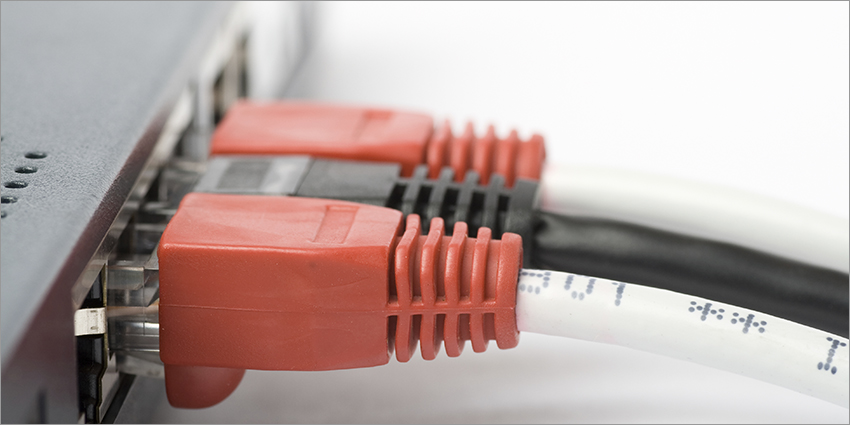Here’s a solution I often recommend to clients who want to reduce their level of exposure to Wi-Fi radiation but don’t want to go to the expense of installing broadband cabling. Homeplugs can be used to connect computers and laptops to the internet in different rooms of your home using existing mains wiring, with no Wi-Fi or special cabling required.
Also known as dLan (directly networked) devices, homeplugs have been available since 2003 but surprisingly few people know about them. They are purchased in sets, depending on how many rooms you want to have internet access in, and can be used with any router that is connected to a broadband internet connection.
How to use HomePlugs
- Connect your router to your broadband connection.
- Use an ethernet cable to connect your router to your computer or laptop.
- Plug a homeplug into a mains socket in the same room as the router, and use another ethernet cable to connect it to any port at the back of the router.
- Turn your router and your computer on. If you have a broadband connection, you will automatically be connected to the internet.
- Plug additional homeplugs into mains sockets in other rooms, as required, and connect them to computers or laptops in those rooms via ethernet cables.
That’s it. No expensive broadband cable. No drilling holes in walls. And no Wi-Fi radiation.
Homeplugs compared to cabled broadband and Wi-Fi
Cabled broadband is always best but depending on the quality and speed of homeplugs you use, the internet connection with homeplugs is usually faster and more reliable than Wi-Fi. Most systems will allow you to use up to 10 computers or laptops simultaneously, which may result in slower speeds, but the same would be true when using Wi-Fi too.
In terms of health effects, it must be said that homeplugs are not as good a broadband cabling because they do add some radiofrequency (RF) noise to the mains wiring. In most of the homes we have lived in, Richard and I never noticed any effect at all. In one, we found we always had busy dreams and surfed on the surface of sleep rather than sinking deeply if we ever forgot to turn the router and homeplugs off at night. We think the difference was caused by the way the house wiring circuits were laid out.
There may be other effects, too, but experts in this field agree they are negligible and vastly preferable to the known health hazards of prolonged exposure to Wi-Fi.
Turning off Wi-Fi
Having installed your homeplug system, be sure to disable the Wi-Fi on your router and computers or laptops, otherwise it will just keep on running. Some routers have an on/off button that makes this really easy. With others, you have to delve deep into the bowels of the software to turn it off. And with some, you can turn off the Wi-Fi but they have DECT technology built-in and continue to emit high levels of microwave radiation 24/7 regardless.
BT Home Hubs have been engineered to give free Wi-Fi access to anyone passing through your neighbourhood who subscribes to BT broadband. The company claims to have over 5 million hotspots around the UK, and this is how they do it. Great for them, and great for people on the move, but it exposes you to increased microwave radiation in your own home unless you turn the feature off. If you use BT broadband, be aware that it works with any type of router so you don’t have to use the free Home Hub they provide. Just replace it with a different type, such as Netgear, that has an on/off Wi-Fi button that really works.
Security
The homeplug system works best for people sharing a house who are happy to share data too. If you live in an apartment that shares wiring with other apartments, be sure to activate the encryption that is built into the software by entering a different password to the factory default.
Resources
If you have any technical questions about homeplugs, please don’t email me but use the link below instead:
Copyright © Karen Kingston 2012





Hi Karen,
In fact, HomePlug radiation levels are comparable and usually higher than WiFi. The reason is that the high frequencies injected into the power lines by HomePlug turn all the power lines in the house into transmitting antennas. Nothing spooky or sinister about that – it’s basic physics – you have a piece of metal with high frequency current flowing over it (2-28 MHz for HomePlug, if I’m not mistaken) starts emitting radio waves. It’s unavoidable without shielding, and power lines in the house do not have shielding.
If you are not convinced, here is some info from HomePlug.org:
http://www.homeplug.org/tech/whitepapers/HP_1.0_TechnicalWhitePaper_FINAL.pdf
Note that mention that special effort was needed when designing HomePlug to ensure that the radiation stays below the specifications. Also, they specifically leave some frequency bands that home electronics (such as cordless phones use) free – otherwise, the radiation is so strong that that devices cordless phones can’t even function.
So, if you are hoping to reduce electromagnetic radiation exposure via HomePlug, better stick with a low-power WiFi router.
Regards,
– Alex
Hi Alex
Thank you for your comments.
Cabled broadband is always best but many people cannot afford the expense of installing this, or are living in rented accommodation where they may not be allowed to do so.
There is certainly some radiation from HomePlugs, but according to Powerwatch, who have been at the leading edge of EMF research for over 20 years, the levels are negligible compared to WiFi:
http://www.powerwatch.org.uk/science/faq.asp#homeplug
The transmitting power of a HomePlug (dLan adapter) compared to wireless devices in the home is very small indeed:
http://www.detect-protect.com/k/dlanfaq.htm#Frage_013
My husband and I are very sensitive to WiFi radiation and can tell immediately if there is a device turned on in our home. As I mentioned in my blog, in some homes we have lived in, we have felt no effect at all. In one, we found we always had busy dreams and surfed on the surface of sleep rather than sinking deeply if we ever forgot to turn the router and HomePlugs off at night, but during the day it was absolutely fine. In each home we measured RF levels using professional equipment and found no increase. However we do use anti-surge mains conditioners on all our computing and TV equipment to filter out RF interference, as everyone needs to do these days, and this certainly helps.
I have recommended HomePlugs to clients who have developed health problems as a result of WiFi exposure and all have reported an improvement. I will continue to monitor scientific data on this topic, of course, but of much more concern is the level of radiation from DECT (cordless) phones
I’m pretty sure that I have turned off the wireless on my BT Home Hub 3. I followed the instructions at:
http://www.wavegoodbye.info/How_to_turn_off_Wireless.html
and the blue ‘Wireless’ light is now off
Hi David,
We had a BT Home Bub 3.0 and followed instructions to turn off the wireless. The blue wireless light went out, but when we checked it with an Acoustimeter (a device that measures microwave radiation), we discovered it was still emitting very high levels. With BT Home Hubs 1.0, 1.5 and 2.0, there is absolutely nothing you can do about this. With BT Home Hub 3.0, I’m told you can call BT and ask them to unsubscribe you from what used to be called BT FON and is now called BT Wi-Fi, and your Home Hub 3.0 will no longer be a public hotspot. There was no information available about this at the time we discovered the problem with ours, so we remedied it by replacing the Home Hub with a different make of router.